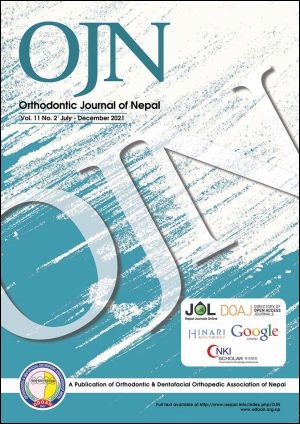Correlation of vertical dimension with lip position, nasolabial angle and incisal display at rest and at smile in young adults
DOI:
https://doi.org/10.3126/ojn.v11i2.43270Keywords:
Vertical dimension, Incisal display, Uper lip length, Lower lip length, Nasolabial angleAbstract
Introduction: Photography has been given a great importance in diagnosis in orthodontics, the study of certain aesthic parameter on digitilzed photographs can provide an additional diagnostic tool. This study is designed to compare facial parameters and various photographic parameters among patients with long, average, short faces in central Indian population. Also an alternative method to cephalometric analysis needs to be worked upon which is reliable, easily assessable and convenient for multiple usage by the orthodontist to direct his/her treatment.
Materials and Methods: 150 subjects (75 males and 75 females) selected and examined by two methods clinical examination and photographic examination by using ImageJ software.
Results: The results of this study shows there is significant correlation between vertical dimension, incisal display upper lip length, lower lip length and nasolabial angle and there is no significant difference between clinical examination and photographic examination done with Image J software.
Conclusion: This study concluded that the vertical proportions of facial soft tissue follow the underlying vertical skeletal pattern, high vertical dimension is associated with short upper lip, more incisal display and high clinical FMA. The low vertical dimension is associated with acute nasolabial angle and low clinical FMA. Photogrammetry was found to be a quick easy, cost effective and reliable diagnostic tool which can reduce radiation exposure and reduce the number of cephalograms during treatment
Downloads
Downloads
Published
How to Cite
Issue
Section
License
Copyright (c) 2021 Orthodontic & Dentofacial Orthopedic Association of Nepal

This work is licensed under a Creative Commons Attribution 4.0 International License.
Copyright © held by Orthodontic & Dentofacial Orthopedic Association of Nepal
- Copyright on any research article is transferred in full to the Orthodontic & Dentofacial Orthopedic Association of Nepal upon publication in the journal. The copyright transfer includes the right to reproduce and distribute the article in any form of reproduction (printing, electronic media or any other form).
- Articles in the Orthodontic Journal of Nepal are Open Access articles published under the Creative Commons CC BY License (https://creativecommons.org/licenses/by/4.0/)
- This license permits use, distribution and reproduction in any medium, provided the original work is properly cited.




